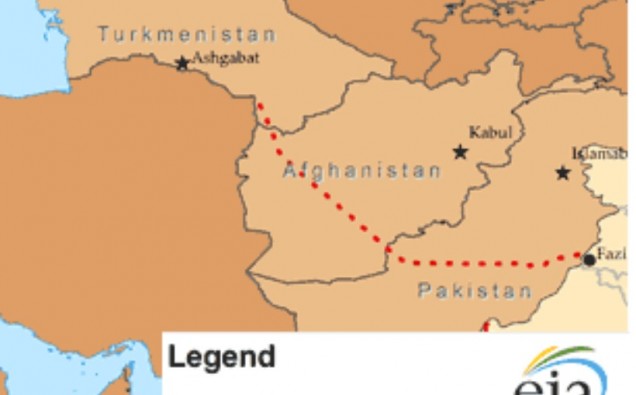
Energy-starved South Asia with a burgeoning population and food-deficient Central Asia with surplus energy, have entered into landmark agreements – known as TAPI and CASA-1000 – in a proposition that promises to be win-win for all.
Work on the construction of Turkmenistan-Afghanistan-Pakistan and Afghanistan (TAPI) gas pipeline recently started to translate a quarter century old dream of Asian energy grid into a reality.
CASA (Central Asia South Asia)-1000 is a $ one billion project on import of electricity from Central Asian nations- Tajikistan and Kyrghyzstan to light homes in Afghanistan and Pakistan. An agreement on execution of this project was signed in December 2014.
Though, 1000 megawatts is not going to provide a quantum jump in terms of availability of the electricity to Pakistan as the current power shortfall in this country in summer ranges between 5,000 to 6000 megawatts. The other beneficiary of the power imports from Central Asia is Afghanistan that will get 300 megawatts under the CASA-1000 arrangement.
The construction of 1200-kilometers long transmission lines traversing two Central Asian countries and Afghanistan before entering Pakistan though seems an uphill task, as peace and stability remain a distant dream in Afghanistan in the face of Taliban insurgency and fissures in the Kabul coalition government. But the recently held Heart of Asia Conference in Islamabad has helped further strengthen the neighboring countries’s resolve to bring peace to this war-torn country. This event also provided an opportunity to two major stake holders of the Afghanistan peace process- Pakistan and India to resume their own peace talks, a much-needed development towards sustainable peace in South Asia and economic well being of more than one-fifth of the world population living in the region.
In South Asia, various types of fuels are being used to generate power. Even before CASA-1000, Pakistan had signed an agreement with Iran for the import of 1000 megawatt. A small quantity of Iranian electricity is already being imported for Gwadar and other coastal areas of Balochistan. According to a World Bank report, energy-rich countries such as Nepal, Bhutan, Iran, and Central Asian economies could benefit from this opportunity that would simultaneously meet growing demands of energy deficient counties such as India, Afghanistan, Pakistan and Bangladesh.
Energy trade in South Asia constitutes less than 5% of total trade within the region. The energy trade among South Asian has been of bilateral nature only. India-Bhutan electricity trade began in 1974 with the construction of a hydroelectric plant in Bhutan. India-Nepal electricity trade started in 1971 given Nepal’s immense hydropower potential. Such trade is an attractive option for both countries as Nepal is energy-deficient in the dry season, but has an energy surplus in the wet season.The first cross-border power connection between India and Bangladesh was completed in February 2014. The import of electricity from Central Asia has added a new dimension to energy trade in South Asia, which has combined GDP of three trillion dollars.
The pipeline linking South Asia to gas fields of Turkmenistan was conceived in 1994 as TAP (Trans Afghanistan Pipeline) by an Argentinian firm Bridas. Later, an American company, Unocal came up with rival TAP pipeline. But the turbulent situation in pre and post-9/11 eras stalled the execution of this project. Only in the year 2006, India agreed to join the project, giving the name Turkmenistan-Afghanistan-Pakistan-India (TAPI) gas pipeline.
Pakistan and India pushed for materialization of TAPI project only after the Iran-Pakistan-India pipeline project could not be take off due to international sanctions on Tehran.Now work on TAPI has been commissioned and Pakistan government has initially allocated US $ 200 million equity share. The TAPI pipeline will have a capacity to carry 90 million standard cubic meters a day (32 billion cubic meters per year) gas for a 30-year period and is targeted to be operational in 2018.
Meanwhile, China, the second largest world economic power after the United States, is also investing around $ 46 billion in development of energy and trade infrastructure through Pakistan under China Pakistan Economic Corridor. The massive project will also benefit the region for both trade expansion and energy supplies. All surrounding regions including South Asia, Central Asia and the Gulf stand to benefit from commercial links through Gwadar deep sea port..
The project looks a potential regional energy avenue – an Asian Energy Grid. However its success in fueling the regional economies will need a relatively peaceful Afghanistan as well as sustained improvement in Pakistan-India relations.












